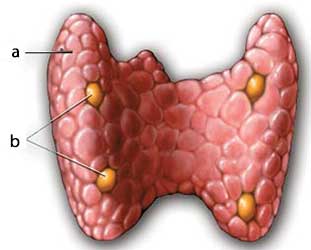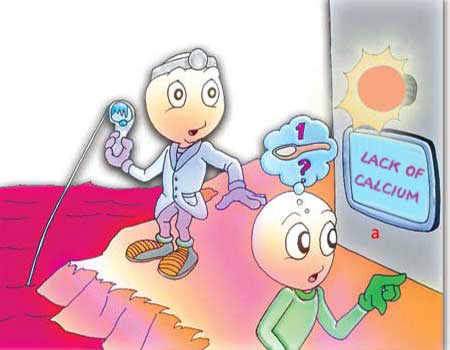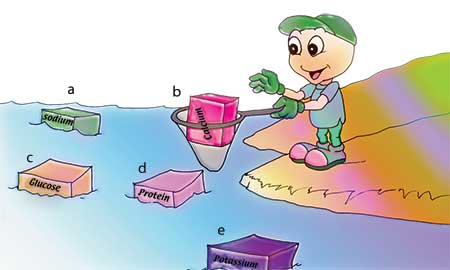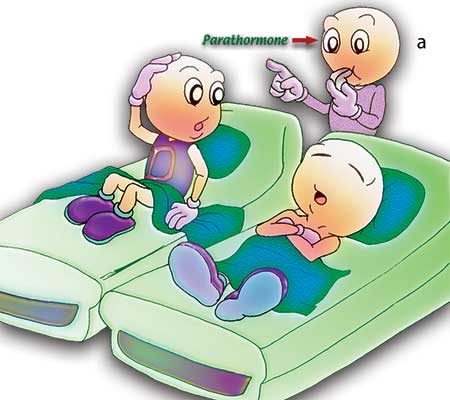Khe level of calcium in the blood is of vital importance for survival. In the same way that a human being has to breathe and drink water in order to stay alive, he or she also needs a particular level of calcium in the blood. When the amount of calcium in the blood falls below the level required, the individual dies.
 |
| Figure 17: There are some 2 kilograms (4 pounds) of calcium in the adult human body. |
Calcium enables our bodies to carry out many vital functions.. For one thing, in the absence of calcium, blood will not clot—in which event, even a small wound or cut could prove fatal due to loss of blood. Calcium also plays an important role in the transmission of nerve signals, enables the muscles to function, and contributes to bone strength. The body of every healthy adult contains some 2 kilograms (4 pounds) of calcium. (Figure 17). Some 99% of this calcium is stored in the skeletal system; the rest is employed in processes related to metabolism. Only 0.5 grams (0.01 ounces) of calcium needs to be present in the bloodstream for bodily functions to be maintained..2
Let us now consider the following imaginary scenario: A one-liter (33- ounce) bottle of blood is placed in front of you. You are told that this blood is to be transfused into a patient awaiting an operation—but that there is a problem. This blood is calcium-deficient, although the extent of this deficiency has not been determined.
You are also given a large bowl full of powdered calcium and told to make good the deficiency (Figure 18).
What would you do?
First, you would have to measure how much calcium is lacking. In order to do this, however, highly advanced technological equipment is necessary, and you lack both the time and the means. That being so, there is little you can do.
Yet in the body of every human being, there is a magnificent mechanism that calculates the level of calcium at every moment and takes the necessary measures. The thyroid gland and the parathyroid gland—another hormonal gland buried inside the thyroid—function in line with a most rational plan in order to maintain the calcium balance in the body. The parathyroid gland's sole function is to measure the amount of calcium in your blood, 24 hours a day, throughout your entire life, and to keep it at the ideal level (Figure 19).
The parathyroid gland controls the level of calcium in the blood by means of the parathormone it produces. If the amount of calcium in the blood falls, it immediately releases parathormone3 (Figure 20).3
The parathyroid gland is a small piece of tissue. How does a piece of tissue consisting of cells identify the calcium atoms in the bloodstream flowing before it? How do cells with no eyes, ears or sensory organs identify calcium atoms from among thousands of different substances in the blood—salt, glucose, fat, amino acids, proteins, hormones, enzymes, lactic acid, carbon dioxide, nitrogenous wastes, sodium, potassium, urea, uric acid, iron and bicarbonate? How does the cell recognize this one element, calcium, out of all these others? How does it know the ideal level of calcium there needs to be in the blood? By what consciousness does it measure that level? How does it decide whether there is too much or too little?
 |
| a. Thyroid gland, |
| Parathyroid glands identify calcium from among the millions of molecules in the blood and take the appropriate precautionary measures to maintain the ideal level of calcium in the blood. |
Remember that these parathyroid cells have no intelligence or consciousness, and are only 1% of a millimeter in size. That they are able to successfully measure the level of calcium in our body on our behalf is just one of the proofs of the creation of the Omniscient and Almighty God.
If, as a result of their measurements, the parathyroid cells determine that the calcium level has fallen, they immediately secrete parathormone. But how is the level of parathormone raised, and how is this tiny molecule able to locate stored calcium? Parathormone finds sources of calcium to replenish the blood from three different sources, each of which requires a sophisticated biological knowledge:
1. There are high levels of calcium in the bones. Parathormone borrows some calcium from the bones. The bones, under normal conditions, are reluctant to release the calcium. When they encounter the parathormone formula, however, they naturally release a small quantity of calcium (Figure 20).
2. A certain quantity of the calcium in the blood is expelled from the body through urine. This calcium needs to be re-combined with the blood once again. To accomplish this, the kidney cells need to capture the calcium molecules in urine and to return them to the bloodstream.
This time, parathormone issues this command to the kidney cells. The cells obey the command and extract the calcium molecules (Figure 21).
3. New sources of calcium enter the body through the food we eat. That calcium in is mixed with the blood in the small intestine. However, in order not to re-absorb the calcium, the intestine cells need activated Vitamin D. But the Vitamin D obtained through food is not in an active state4And so, at this point, a major problem emerges that must be resolved in order for the intestine to absorb more calcium, and thus to raise the level of calcium in the blood. In other words, a very special molecule is needed to alter the chemical structure of the non-activated Vitamin D. This molecule that activates Vitamin D, once again, is parathormone (Figure 22).
 |
| a. Lack of Calcium |
| Figure 18: The parathyroid gland's task is to measure, day and night, how much calcium there is in your blood and to maintain it at the ideal level. Whenever it determines that the level of calcium in your blood has fallen, it takes immediate precautionary measures. |
We now need to reflect with great care. There are three different ways of raising the level of calcium in the blood, yet the key that starts these three very different systems is the same in each case. This key turns the three systems on. Even more amazingly, when these three systems, with their very different structures and methods of operation, are turned on, the result is exactly the same: a rise in the level of calcium in the blood.
 |
| a. parathyroid, b. close, c. open |
| Figure 19: When the level of calcium in the blood falls, the parathyroid immediately intervenes by releasing parathormone. Figure 20: Parathormone increases the level of calcium in the blood in three different ways. |
How did the parathyroid cells arrive at the formula for this triply-effective hormone? How do they know that this molecule will affect the bones and kidneys as well as Vitamin D in the intestines? How is it that the parathyroid glands of all the humans who have ever lived have—except in cases of illness, managed to produce this correct formula? How do parathyroid cells know that the bones store calcium, that there is calcium in urine in danger of being excreted from the body, and that the small intestine cells require activated Vitamin D in order to absorb passing calcium? How did they find the single chemical formula to make these three systems work? How can unconscious cells display this kind of intelligence that confounds even knowledgeable human beings?
 |
| Figure 20: When necessary, the parathormone borrows some calcium from the bones. Although under normal circumstances, the bones are reluctant to release calcium, they do release a specific amount when they come into contact with parathormone. |
It is of course God, the Compassionate and Merciful Lord, Who manifests this intelligence and planning in the cells, Who created the cells, and the calcium, and human beings from nothing, Who created human beings in need of the calcium molecule, and who then established this immaculate system in order to meet that need. Certain it is that God's glory is very great.
 |
| a. Sodium, b. Calcium, c. Glucose, d. Protein, e. Potassium |
| Figure 21: You would need to be an expert with considerable training and technology to locate the one chemical you were looking for in a river containing many chemical substances. Yet hormones successfully achieve this feat on their own, with no special equipment. |
God, there is no deity but Him, the Living, the Self-Sustaining. He is not subject to drowsiness or sleep. Everything in the heavens and the earth belongs to Him. Who can intercede with Him except by His permission? He knows what is before them and what is behind them, but they cannot grasp any of His knowledge save what He wills. His Footstool encompasses the heavens and the earth, and their preservation does not tire Him. He is the Most High, the Magnificent. (Surat al-Baqara, 255)
 |
| a. parathormone |
| Figure 22: When the need arises, parathormone activates the non-activated Vitamin D by changing its chemical structure. It awakens the vitamin, almost as if it had been hibernating. |
2- Musa Ozet, Osman Arpaci, Biyoloji 2 (“Biology 2”), Surat Yayinlari, Feb 98, p. 127.
3- Helena Curtis, Sue Barnes, Invitation To Biology: 4th ed., New York, Worth Publisher, INC, August 1985, p. 472.
4-Biological Science: A Molecular Approach, BSCS Blue Version6th ed., Colorado 1990, p. 517.